#in the criminal justice system
Text

#do they even know#svu#incorrect quotes#law and order svu#incorrect svu#shitpost#elliot stabler#olivia benson#bensler#eo#in the criminal justice system
1K notes
·
View notes
Text
I like on Law & Order when opening and closing arguments are only like 90 seconds but in real life they last approximately 1900 hours.
#us politics#donald trump#law & order#in the criminal justice system#had to work in a golden girls reference though
0 notes
Text
Me: *is fully able to skip the SVU intro*
Also me: IN THE CRIMINAL JUSTICE SYSTEM SEXUALLY BASED OFFENSES ARE ESPECIALLY HEINOUS IN NEW YORK CITY THE DEDICATED DETECTIVES WHO INVESTIGATE THESE FELONIES ARE MEMBERS OF AN ELITE SQUAD KNOWN AS THE SPECIAL VICTIMS UNIT THESE ARE THEIR STORIES
DUN DUN
1 note
·
View note
Text
AU where Jason gets his revenge by becoming a lawyer and getting joker sentenced to the death penalty
Bruce is conflicted about it but any time he tries to say anything on the subject Alfred just talks over him like "oh we're so proud of you master Jason you finished college and you didn't even use your father's extensive resources that could've easily gotten someone in this family a degree aren't we so proud master Bruce that Jason got himself a respectable profession--"
#jason todd#red hood#batfam#i also think it would be funny if thats literally the only thing jason does as a lawyer after that he just goes back to being a vigilante#everyone on the internet is like 'the iconic career of jason todd wayne: came back from the dead got a college degree got the joker-#-sentenced to death (finally) and then immediately fucked off to do whatever the hell it is he does for fun'#any time bruce and jason disagree jasons like 'excuse me which one of us is the college drop out and which of us is a practicing attorney?'#alfred 'you could have been a doctor but you became a furry themed vigilante instead' will never let this go#also btw jason just stole reasources from the league to get thru college. maybe at first talia was like what & then jason was like#'my alternate plan was to either get bruce to kill the joker or kill all three of us in an explosion' and talia is like#'okay. have fun at school sweetie'#BTW AN EDIT: this post is not reflective of my IRL beliefs about the criminal justice system or the death penalty#IRL those are way more complicated than gotham city/the joker/jason make it out to be#saw a few people tagging this post mentioning stuff about that
29K notes
·
View notes
Text

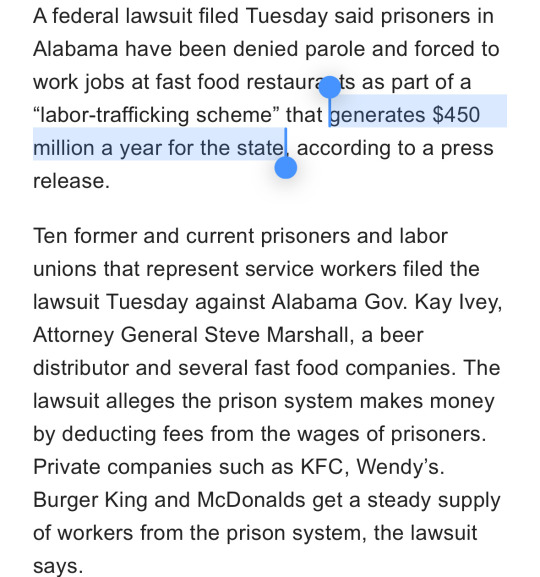
Source
Reminder that 53% of Alabama’s prison population is black people who are incarcerated at 3x the rate as white people (source).
#prisons#abolish prisons#criminal justice#criminal justice system#news#Alabama#current events#workers rights#workers#capitalism#government
2K notes
·
View notes
Text
"The New York City Council voted to ban most uses of solitary confinement in city jails Wednesday [December 20, 2023], passing the measure with enough votes to override a veto from Mayor Eric Adams.
The measure would ban the use of solitary confinement beyond four hours and during certain emergencies. That four hour period would be for "de-escalation" in situations where a detainee has caused someone else physical harm or risks doing so. The resolution would also require the city's jails to allow every person detained to spend at least 14 hours outside of their cells each day.
The bill, which had 38 co-sponsors, was passed 39 to 7. It will now go to the mayor, who can sign the bill or veto it within 30 days. If Mayor Adams vetoes the bill, it will get sent back to the council, which can override the veto with a vote from two-thirds of the members. The 39 votes for the bill today make up 76% of the 51-member council. At a press conference ahead of the vote today [December 20, 2023], Council speaker Adrienne Adams indicated the council would seek [a veto] override if necessary.
For his part, Mayor Adams has signaled he is indeed considering vetoing the bill...
The United Nations has said solitary confinement can amount to torture, and multiple studies suggest its use can have serious consequences on a person's physical and mental health, including an increased risk of PTSD, dying by suicide, and having high blood pressure.
One 2019 study found people who had spent time in solitary confinement in prison were more likely to die in the first year after their release than people who had not spent time in solitary confinement. They were especially likely to die from suicide, homicide and opioid overdose.
Black and Hispanic men have been found to be overrepresented among those placed in solitary confinement – as have gay, lesbian and bisexual people.
The resolution in New York comes amid scrutiny over deaths in the jail complex on Rikers Island. Last month, the federal government joined efforts to wrest control of the facility from the mayor, and give it to an outside authority.
In August 2021, 25-year-old Brandon Rodriguez died while in solitary confinement at Rikers. He had been in pre-trial detention at the jail for less than a week. His mother, Tamara Carter, says his death was ruled a suicide and that he was in a mental health crisis at the time of his confinement.
"I know for Brandon, he should have been put in the infirmary. He should have been seeing a psychiatrist. He should have been being watched," she said.
She says the passage of the bill feels like a form of justice for her.
"Brandon wasn't nothing. He was my son. He was an uncle. A brother. A grandson. And he's very, very missed," she told NPR. "I couldn't save my son. But if I joined this fight, maybe I could save somebody else's son." ...
New York City is not the first U.S. city to limit the use of solitary confinement in its jails, though it is the largest. In 2021, voters in Pennsylvania's Allegheny County, which includes Pittsburgh, passed a measure to restrict solitary confinement except in cases of lockdowns and emergencies. The sheriff in Illinois' Cook County, which includes Chicago, has said the Cook County jail – one of the country's largest – has also stopped using solitary confinement...
Naila Awan, the interim co-director of policy at the New York Civil Liberties Union, says that New York making this change could have larger influence across the country.
"As folks look at what New York has done, other larger jails that are not quite the size of Rikers will be able to say, 'If New York City is able to do this, then we too can implement similar programs here, that it's within our capacity and capabilities," Awan says. "And to the extent that we are able to get this implemented and folks see the success, I think we could see a real shift in the way that individuals are treated behind bars.""
-via NPR, December 20, 2023
#prison system#prison#jail#criminal justice system#criminal justice reform#prison industrial complex#us news#united states#new york#nyc#new york city#rikers island#eric adams#solitary confinement#us politics#police brutality#cw police brutality#cw death#cw suicide#prison reform#carceral state#good news#hope
436 notes
·
View notes
Text
Spanking is to parenting what prisons are to criminal justice. Allow me to elaborate:
What does spanking do? “It teaches kids to behave!” Actually, no. It teaches kids to fear their caregiver(s). But say we go with that line. How does spanking teach kids to behave? “It shows them the consequences of bad actions!” Actually, no. It shows kids that when the caregiver is displeased, the kid gets hurt. In the mind of the child, the sequence of events is not [misbehave:consequence]. It is [caregiver unhappy:pain]. And maybe you’ll say “But my kid stopped mouthing off after I started spanking them for it”. Okay, sure. Maybe they stopped responding when you argue, but only because the learned to fear what their response would bring. They’re not holding their tongue because they realized it’s disrespectful or rude or whatever else you believe it is. They’re holding their tongue because they know it won’t do any good and will only make the situation worse for them. I can guarantee they are still thinking all those rebellious naughty talk-backy thoughts. They just aren’t saying them out loud. Spanking did not teach your child to behave, it taught them to walk on eggshells.
Similarly, prisons do absolutely nothing to enforce laws. Prisons do nothing to fix the real crimes that do get committed. A shooter or rapist or embezzler being incarcerated does not bring their victim back to life, un-traumatize them, or make reparations for any damages. Additionally, it makes life a living hell for the innocent people who end up in jail (OF WHICH THERE ARE A HELL OF A LOT). And maybe you might say that the point of prison is to encourage good behavior, because no one wants to go to jail. I would ask, then, why there are so many prisons, of which so many are full or overcrowded. Clearly, the threat of incarceration is not keeping people out of jail. Additionally, much like a child who was spanked being afraid to do normal things in their own home for fear of displeasing their caregiver, regular non-criminal people are afraid of prison, even though they have done nothing wrong. They know they could be incarcerated because of falsified evidence, biased testimonies, unfair trial, or simply bigotry. Especially people of color. Even though they haven’t done anything wrong, they are scared of what could happen to them if the person in power (police) was unhappy with them.
Negative consequences unrelated to the actual incident do not discourage “bad behavior”. Just like a child who is spanked will simply learn to be sneakier, a thief who goes to jail will simply cover their tracks better next time.
Stop spanking your kids, and abolish prisons. Have a nice day.
#gentle parenting#criminal justice system#prison abolition#police brutality#parenting#corporal punishment#prison system#child abuse#don’t hit your fucking kids
635 notes
·
View notes
Text


#Kalief Browder#Trump#criminal justice system#solitary confinement#racial disparities#injustice#systemic racism#racism#discrimination#racial inequality#social justice#civil rights#racial bias#racial prejudice#racial discrimination#racial justice
211 notes
·
View notes
Photo

Okay, time to get pretentious and REALLY talk about this shot.

So put on your over-analysis goggles, and let’s talk about the Imperial Cog, Renaissance-era military forts, 18th century prison architecture, the military-industrial complex, the surveillance state, and why this single shot of Mon Mothma standing in a doorway in “Nobody’s Listening!” (the 9th episode of Andor season one) is making me so feral I want to kiss Luke Hull and his entire production design team right on the mouth.

For those of you not in the know - the shape on the screen behind Major Partagaz is the crest of the Galactic Empire - often called the Imperial Cog. It appears throughout Star Wars media on flags, tie fighter helmets, uniforms and as a glowing hologram outside ISB HQ.
In canon it was adapted from the crest of the Galactic Republic.
irl it was created by original trilogy costume designer John Mollo. Mollo has stated that the symbol was inspired by the shape of historical fortifications.

Bastion forts (aka star forts) first appear during the Renaissance with the advent of the cannon. Their shape eliminated blind spots, allowing for a 360 degree field of fire.
An apt metaphor for the Empire. Powerful, imposing and leaving you with nowhere to hide.
The Imperial crest also strongly resembles a gear or cog - hence the common “Imperial Cog” nickname.
Given how inextricably linked military and industry are, it’s also an apt metaphor. Both alluding to the Empire’s massive industrial power, and how it treats all of its citizens with a startling lack of humanity, valuing them only for what they are able to produce for the Empire.

The idea of the cog is repeated in the shape of whatever it is that they’re producing in the prison. They’re literally cogs in the Imperial machine making more cogs for the machine... while inside a larger cog.

This shape, in relation to a prison, also references something else which was almost certainly intentional on the production team’s part.
In the 1791 British philosopher and social theorist Jeremy Bentham proposed a design for a prison he referred to as the “panopticon” - the name derived from the Greek word for “all seeing”.
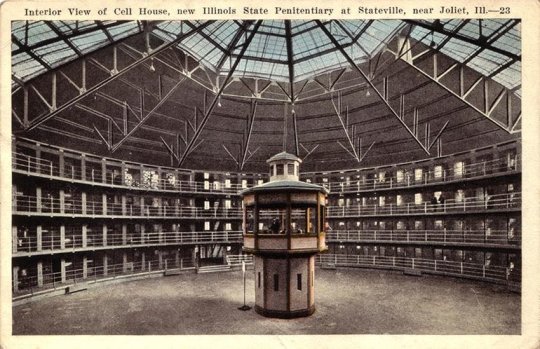
The basic design for the panopticon was a large circular rotunda of cells with a single watchtower in the center. The plan would allow a single guard to theoretically observe every cell in the prison, but more importantly cause the prisoners to believe they are under surevillance at all times, while never being certain.
Later philosophers (notably Michel Foucault) used the panopticon as a metaphor for social control under totalitarian regimes or surveillance states. The perceived constant surveillance of a panopticon causes prisoners to self-police due to the belief they are always being watched, even if they don’t know for certain that is true. They live in constant fear even if nobody is actually watching them, even if “Nobody’s Listening!”
The idea of the metaphorical panopticon has in more recent years been adapted to many other examples of social control: CCTV, social media and business management...
Like the concept of cubicles in an open floor plan office.

So that all being established - let’s finally talk about Mon Mothma’s apartment.
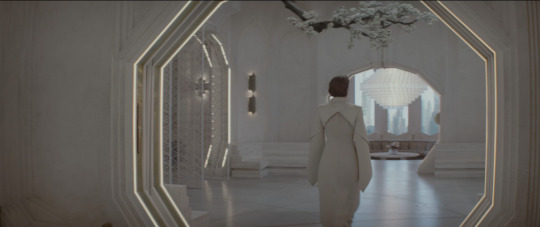
The cog shape is everywhere. There’s hardly a shot where at least one cog isn’t visible. Every room is connected by cog-shaped doorways.

The shape serves as a backdrop to most scenes, often centered and featured prominently.
(Side Note: The cog also appears as a repeated pattern on room dividers with the interesting added detail of intersecting lines that make them resemble spider webs.

The fact that Mon is often filmed directly through these web-like screens (particularly when conducting rebellion business) leads me to believe that this was a very intentional choice.
Even in the very heart of the Empire the nascent Rebellion is starting to build a web of networks and intelligence.)
I had originally presumed that the repeated appearance of the cog was just Luke Hull and his production team adding some brilliant visual storytelling to their already amazing sets. But the following line from episode ten leads me to believe they intended for these details to have an in-story explanation as well.
When speaking to Tay and Davo Skuldon about the apartment Mon states that “It’s state property. The rules are strict on decor. Our choices for change are limited.”
While it’s unclear whether the “state” in this instance is Mon’s home planet of Chandrila or the Empire itself - that second option makes the decor even more insidious.
If Mon’s apartment is Empire property that means the shape of the doors is intentional in-world, not just for the sake of visual storytelling. It means that this was a conscious decision by the Empire. A reminder to even the richest and most powerful of its citizens that they are always watching - whether you can see them or not.
Which brings us back to our original shot.

My favorite thing about this shot isn’t just that is shows how very alone Mon Mothma is.
It isn’t just that she’s in the heart of the Empire, surrounded and dwarfed - just another cog in their machine.
It isn’t just that’s she trapped in her own metaphorical prison, worrying her self sick about who may be watching, not safe even in her own home.
What makes this shot truly extraordinary to me, is that right in the midst of the Empire you can see a new symbol forming.
Forming with Mon Mothma right at the center.

It’s a bit blocky, still constrained by the the harsh lines of the Empire, but giving how intentional every design decision on this show has been I find it pretty hard to believe it’s there by accident.
A symbol that will one day adorn the helmet of a boy from Tatooine.
One that will come to represent what all rebellions are built on...

#andor#andor spoilers#star wars#HOW IS THIS SHOW SO GOOD?#mon mothma#production design#history#long post#whose extensive knowledge of star wars and the history of the criminal justice system is useless now MOM
3K notes
·
View notes
Text

#criminal justice#criminal Justice system#cancel state#politics#justice#marijuana#war on drugs#race#USA#memes
504 notes
·
View notes
Text
Saw a post about the sex offender list that kept repeating, "police love to get minorities for X crime" and I realized, both people who supposedly oppose the system and the system itself very intentionally frame police and police discretion as a more powerful and unilateral part of the system that it actually is, while ignoring or obscuring the rest of the system.
The DA's office decides what cases to drop and what to move forward with, and what punishments to request. The judges decide to throw out cases or let them continue, and then use judicial discretion in handing down sentences. And so on, I am not a legal expert yet, but there's a whole chain of people more powerful than some beat cop who chose to pursue or drop cases.
This all seems very convenient for the DA, as nobody is rioting to abolish or defund their office.
#criminal justice system#criminal justice#American legal system#original post#judicial system#policing
82 notes
·
View notes
Text
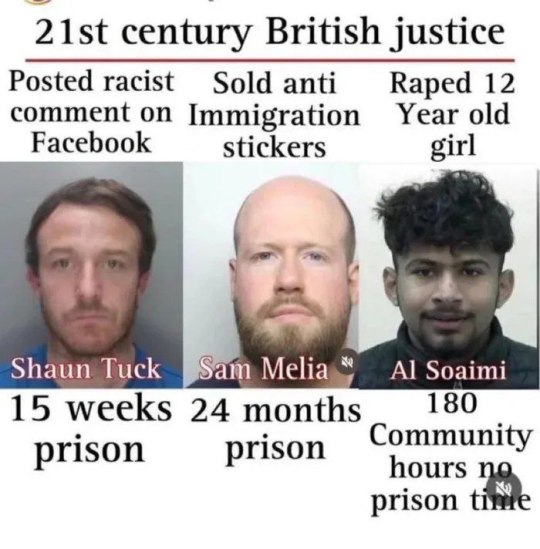
87 notes
·
View notes
Text
youtube
Free Black Mamas DMV - Donate here if you can
56 notes
·
View notes
Text

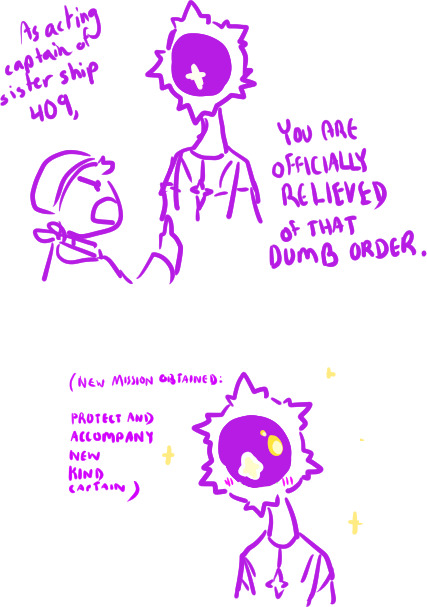
in case anyone was wondering, yes, Eclipse does make an appearance in the space au. And yes, he IS incredibly lonely and in need of a hug (good news pilot reader is dumb enough that they’d hug a giant menacing four armed robot with like -2 seconds of thought)

(Info abt when in the story they find Eclipse below):

#bones of a rabbit art#bones of a rabbit fnaf#bones of a rabbit fic#fnaf x y/n#fnaf au#fnaf space au#fnaf sun/moon x reader#fnaf eclipse x reader#space ai sun#space ai moon#space ai eclipse#space au#space ai au#spaceship ai au#also yea Eclipse knows like right off the bat that Reader is a thief/criminal#and he Does Not Care#he wasn’t built with the same strict adherence to laws and the modern justice system like Sun and Moon were#doodles#sketches#fanfic concepts#fanfic lore
1K notes
·
View notes
Text
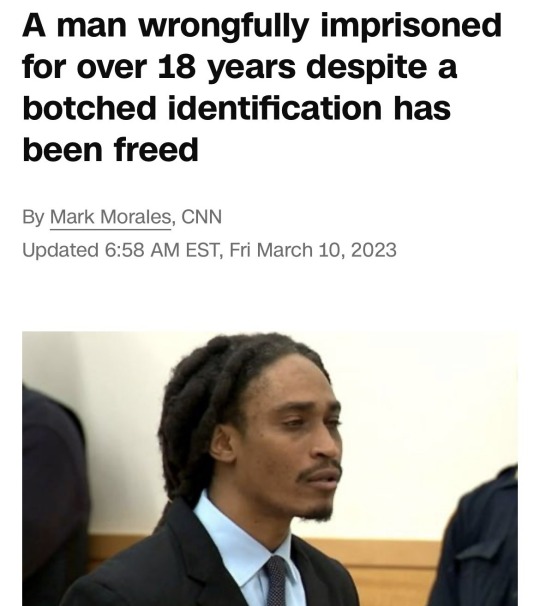
Source
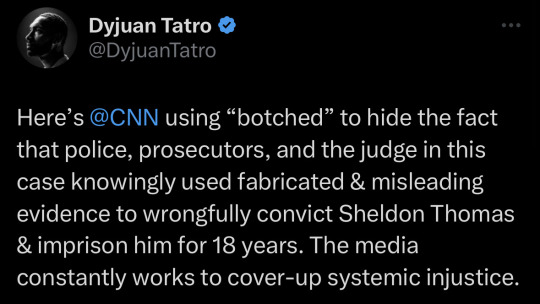
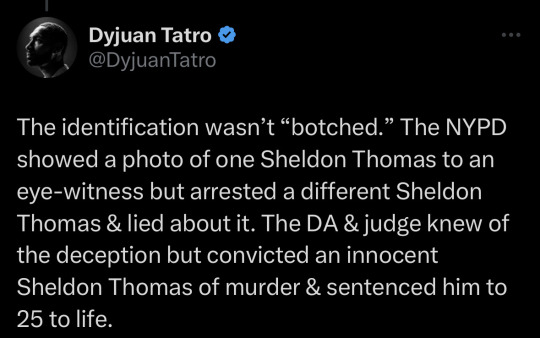
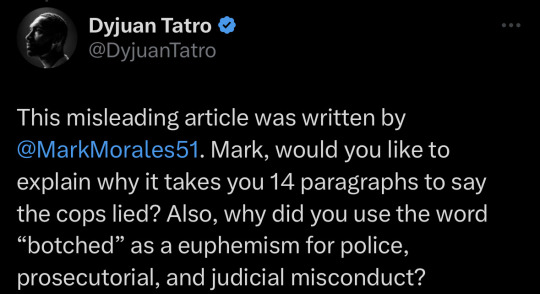
#criminal justice#current events#mass news media#racism#judicial system#criminal justice system#politics#us politics#government#the left#news
14K notes
·
View notes
Text
YR Season 3 speculations: a layperson’s take on the criminal justice side
I’ve been considering making this kind of post for a while, because I’ve seen a lot of hopeful takes on how things are going to play out now that Sara has called the police, and I feel like I could add some perspective for those less familiar with the Swedish justice system. I hesitate to do it because I’m just a layperson and not even from Sweden but the next country over - but our justice systems are reasonably similar, I’ve spent a lot of time poring over relevant sources on Swedish law and justice, and @scatteredpiecesofme encouraged me to do this after our conversation yesterday.
So, here goes, haha.

As usual, I could very well be wrong about some things, and I welcome any additions or corrections!
Part 1: The system
Let’s start with a cultural observation: the criminal justice system in Sweden strives to be rehabilitative (restorative) instead of strictly punitive (retributive). This is especially true for young and first-time offenders, who are yet to develop a ‘criminal lifestyle.’ Fines, suspended sentences, and sentences on the lower end of the scale are the norm unless the crime is very serious. (See for example this text in Swedish about how the brain only fully matures at 25 and how young people experience punishments more severely.)
Swedish law recognises three different age brackets for offenders: 15 to 18, 18 to 21, and over 21 (adult). The punishments for young adults were harshened in Jan 2022 for some severe crimes (mostly to counter gang violence), but YR is set in the autumn of 2020 and spring of 2021. With that in mind, let’s review the situation that should apply in the show.
Firstly, the now-outdated law and practice include something known as ungdomsrabatt (juvenile discount). Any sentence given to an 18-year-old is normally reduced to 50% of an adult’s sentence, and a sentence given to a 16-year-old is reduced further so they get about 20-25% of an adult’s sentence. This can either mean a reduced version of the same sentence, or an alternative, more lenient sentence. Punishment can also be waived entirely for juveniles sentenced to minimal fines for minor offences (e.g. minor narcotics offences).
Secondly, there are some punishments specifically designed for young offenders. Ungdomstjänst (youth community service) and ungdomsvård (youth/juvenile care) mostly apply to those under 18 but can also apply to those under 21 where appropriate. The latter is for those in need of social service intervention; it’s an open arrangement where the juvenile continues living at home. Sluten ungdomsvård (institutional youth care) only comes into play in very serious cases. It’s the primary punishment for minors who would otherwise face imprisonment and, under the old law, also for those under 21, unless there are very heavy grounds for prison time.
There is also something called ungdomsövervakning (youth supervision); basically youth care with more restrictions. However, it was only introduced in Jan 2021, which means it cannot be applied to crimes committed earlier (for example in YR S1).
As mentioned, juveniles can also be sentenced to reduced versions of the same punishments as adults. For young adults, that most likely means a suspended sentence and/or community service and/or fines. These fines are often dagsböter (day-fines), which can range from 50 to 1000 kronor based on the defendant’s income, wealth, and debts for example. The minimum number is 30 fines, the maximum is 150, or 200 for several crimes. There can also be some other financial consequences, e.g. a 1000-krona payment to the Crime Victim Fund or compensation for the victim (these are much lower sums than in the US, for example).
Here’s a made-up example from Domarbloggen: three people aged 16, 18 and 22 beat someone up together. The 22-yo gets 4 months’ imprisonment, which means the 18-yo should get 2 months. Instead, she gets a suspended sentence and 75 hours of community service. The 16-yo should get 1 month, but that is commuted to 50 hours of youth community service. Social services are (and must be) involved for the 16 and 18-yo but find that they are not in need of any services.
Thirdly, juveniles are processed differently from adults. If someone younger than 21 is suspected of a crime, the police investigation that starts when the crime comes to light must be conducted without delay. For those under 18, there’s a time limit of 6 weeks from the initial police report to the decision to prosecute. In many cases, the prosecutor can simply decide not to bring charges and hand the matter over to social services instead. (See for example this Q&A document on the old law, in English.)
Young offenders are also often eligible for förundersökningsbegränsning (limitation of preliminary investigation) and åtalsunderlåtelse (no-prosecution deal). In the former, the police and prosecutor decide not to investigate the crime, and in the latter, the suspect confesses their guilt to avoid being charged or tried for that particular crime. There are specific circumstances in which these can come into play - for example, when there are several crimes being investigated/charged and the crime in question would not affect the sentencing, or the sentence would be minor anyway. Here’s more info on the reasoning in Swedish, but it’s basically done to save resources for other crimes. The sentence for all the crimes committed is determined as a whole; it does not necessarily match the sum total of all the individual sentences. Accepting a deal means the crime will still go on the person’s criminal record.
If sufficient evidence is found and the matter does go to trial, the court can decide to hold it behind closed doors if the parties are young and/or to protect them from negative publicity. The judge must also be specialised in juvenile cases if the defendant is under 18.
Trials in this corner of the world are usually rather boring compared to what you see on TV. There’s no jury or heated cross-examination. The facts are presented, the injured party, defendant, and witnesses are heard, and the court considers the case. (Here’s a detailed description and even a 24-minute film in Swedish.)
The bar for detaining young offenders before and after the trial is higher than for adults, but it can happen if they are considered dangerous or there’s a risk of them destroying evidence/influencing the witnesses (for minors, the social services usually watches over them instead). There is no bail system.
Oh, and if someone is sentenced to prison after all, they are not necessarily taken away directly after the trial. Serving the sentence may be postponed until the period of appeal runs out (often 3 months after the sentence enters into force, according to the Prison and Probation Service).
So, now that we know the framework, let’s take a look at the crimes that could come into light in YR S3! Not just those committed by August, but also those committed by Simon and Wilhelm.
Part 2: The crimes committed by the mains in YR
All excerpts quoted are from an English translation of the Swedish Criminal Code. I will include some of my own interpretations in the context of the show - but while reading those, please keep in mind that I’m just a layperson and could well be completely mistaken!
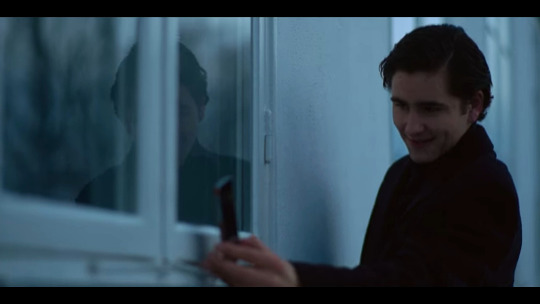
Kränkande fotografering (intrusive photography): August
A person who unlawfully, by means of a technical device, covertly records an image of a person who is indoors in a home, or in a toilet, dressing room or other similar space, is guilty of intrusive photography
(Swedish Criminal Code, Chapter 4, Section 6a)
Scale of punishment for adults: fines or prison up to 2 years.
I don’t think this should be very hard to prove now that Wille has admitted to being on the video. August could of course claim it was someone else using his phone, but I think it should definitely be someone other than Alexander, who had already been caught with the drugs.
Olaga integritetsintrång (unlawful breach of privacy): August
A person who intrudes into the private life of another person by disseminating:
1. an image of or other information about a person’s sexual life;
(...)
4. an image of a person in a very vulnerable situation; or
5. an image of a person’s wholly or partially naked body
is, if the dissemination is liable to result in serious damage to the person whom the image or information concerns, guilty of unlawful breach of privacy
(Swedish Criminal Code, Chapter 4, Section 6c)
Scale of punishment for adults: fines or prison up to 2 years for normal severity, prison from 6 months to 4 years for gross offences.
This is the revenge porn clause. In reality, sadly few cases lead to a conviction; for example in 2021, only 27 out of 1876 cases. The perpetrator can always claim their device/account was hacked, for example, and it’s hard to disprove that. We’ll see if Sara’s testimony and August having admitted his guilt to Wilhelm are enough.
Förtal (defamation): August
A person who identifies someone as being a criminal or as having a reprehensible way of life, or otherwise provides information liable to expose that person to the contempt of others is guilty of defamation
(Swedish Criminal Code, Chapter 5, Section 1)
Scale of punishment for adults: fines for normal severity, fines or prison up to 2 years for gross offences.
Note that defamation does not have to be untrue in Sweden! It’s the ‘exposing that person to contempt’ that matters. However, if the defendant can show that the information was true and they were a) obliged to make this kind of statement or b) it was “otherwise justifiable to provide information about the matter”, they are not held responsible. August’s lawyer would probably argue that spreading the video of Wille was a matter of national importance.
A note on aggravating or special circumstances:
Both unlawful invasion of privacy and defamation can be considered gross if the information or image or the method of dissemination was liable to result in serious damage. This bumps up the potential consequences.
Normally, charges can only be brought for the above crimes by the injured party. However, the prosecutor could also choose to bring charges on their own in cases where public interest calls for it. The same goes for defamation if the injured party is under 18 or reports the crime in connection with another investigation, and public interest calls for prosecution. In this case, it doesn’t matter if the injured party wants the case to be pursued or not. So in my view, any potential resolution where Simon and/or Wille decide not to pursue these crimes should be written very carefully to exclude public prosecution.
There’s also another interesting angle that I haven’t seen thrown around much. It was first brought to my attention by a friend on ao3, and I can’t believe it’s still a thing in 21st century Sweden, but it is.

Högmålsbrott (treasonable offences): August
A person who commits an offence referred to in Chapters 3–5 that involves abuse of the King or another member of the Royal House, or of a person discharging the duties of the Head of State as regent, may be sentenced to imprisonment for at most four years if the offence can otherwise result in imprisonment for at most six months, and for at most six years if the offence can otherwise result in imprisonment for more than six months but at most four years.
(Swedish Criminal Code, Chapter 18, Section 2)
Yes, really. Wille being one of the injured parties could complicate things for August when it comes to the above crimes, because they belong to chapters 4 & 5. He’s not actually going to get six years in prison for gross defamation, that’s just the maximum for adults, but it’s an interesting angle and a potential aggravating factor.
Next up, the elephant in the room.
CP: August
I don’t think I need to describe what this means; you can look it up in Chapter 16, Sections 10a and 10b. I’m not going to write it out so this post doesn’t get flagged.
Scale of punishment for adults: fines or prison up to 6 months for minor offences. Prison up to 2 years for normal severity.
Rickard did say that this could land August in prison, but I am highly sceptical. For comparison, consider this case, where an 18-yo who had 540 images in his possession, 98 of those particularly graphic, was only sentenced to 60 hours of youth community service, despite having disseminated some material on social media on two occasions. Or this one, where an 18-yo who was in possession of a video sent to him via SnapChat for a few months, was sentenced to 45 hours of the same - although he was 17 at the time of the crime.
August was 18, but on the other hand, the video he made and disseminated was short, not very graphic, and meant to defame the people in it rather than arouse those who view it. By law, the age and developmental gap between the victim(s) and perpetrator must also be taken into consideration, and as we know, it’s only two years. I’m inclined to think August is only looking at a minor offence - if charges are even brought at all.
So, the fandom should probably prepare for a more lenient sentence than many are hoping for! Ironically enough, the opposite is true for the next crime, which also applies to Simon and, to a lesser degree, Wille.
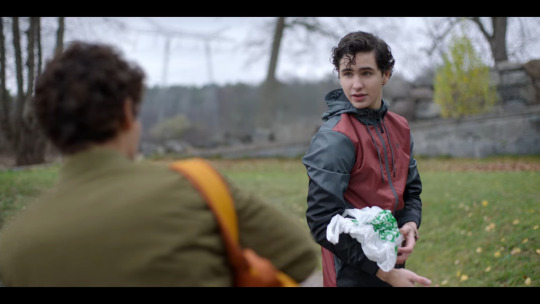
Narkotikabrott (narcotics offence): August, Simon, Wilhelm
Any person who unlawfully
1. transfers narcotics,
2. manufactures narcotics intended for misuse,
3. acquires narcotics for the purpose of transfer,
4. procures, processes, packages, transports, keeps or in some other similar way handles narcotics which are not intended for personal use,
5. offers narcotics for sale, keeps or conveys payment for narcotics, mediates contacts between seller and purchaser or takes any other such measure, if the procedure is designed to promote narcotics traffic, or
6. possesses, uses or otherwise handles narcotics
shall, if he has acted wilfully, be sentenced for a narcotic drug offence
(Penal Law on Narcotics, Section 1)
Scale of punishment for adults: prison up to 3 years for normal severity. Fines or prison up to 6 months for minor offences.
Swedish law is strict on narcotics crimes. Both Simon and August are guilty of several of the above, while Wille is only guilty of use. Wille’s offence would be considered minor, and the punishment might even be waived. However, I think it’s quite likely Simon and August might be looking at normal severity, and Rickard would probably advise August against bringing it up just to spite Simon.
If August went against that advice or the matter came out another way, he would probably get a harsher sentence than Simon on account of his age - although he could provide mitigating circumstances for the selling by saying that Simon coerced him...
In any case, Simon wouldn’t get off with a slap on the wrist either. He sold drugs on two separate occasions - ADHD drugs (which are amphetamine derivatives) and possibly also strong painkillers. Micke’s back pain was specifically mentioned in S1, we saw Simon steal Tramadol (which is an opioid) when he first got pills for August, and there was clearly more in that bag than just the ADHD meds. Amphetamine derivatives and opioids are specifically classified as narcotic drugs due to their potential for misuse, even if the drugs in question (Tramadol and lisdexamfetamine) aren’t as bad as some others.
Furthermore, Simon also committed:
Stöld (theft): Simon
Pretty self-explanatory. Chapter 8, Section 1 of the Criminal Code.
Scale of punishment for adults: fines or prison up to 6 months for minor offences, prison up to 2 years for normal severity, prison from 6 months to 6 years for gross offences.
It’s hard to say what the severity would be. On the one hand, it was just a few boxes and bottles of pills, and the value of the stolen goods should generally be over 1000 kronor to even be considered normal severity (case from 2009). On the other hand, committing theft as part of “criminal activities conducted systematically” is an aggravating circumstance. But I think the prosecutor would be lenient with a 16-yo like Simon and just focus on the narcotics crime (åtalsunderlåtelse for the theft).
Let’s proceed to the last crime, which is something I haven’t really seen a lot of people mention.
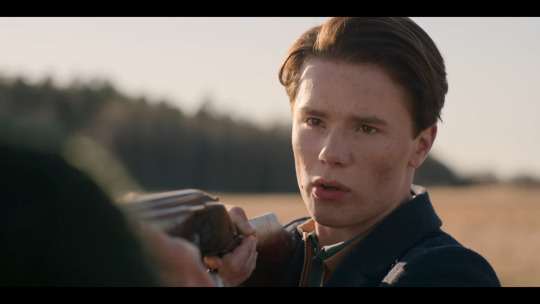
Olaga hot (unlawful threat): Wilhelm
A person who threatens another person with a criminal act in a manner that is liable to occasion serious fear in the person threatened for the safety of their own or someone else’s person, property, liberty or peace is guilty of making an unlawful threat
(Swedish Criminal Code, Chapter 4, Section 5)
Scale of punishment for adults: prison from 9 months to 4 years for gross offences. Fines or prison up to 1 year for normal severity.
It’s highly unlikely that Wille’s shotgun waving would come out unless someone accidentally let it slip when questioned about the other offences. So the risk is slim, but I think it still deserves to be included, because an unlawful threat usually becomes a gross offence when a weapon is used. It’s also a publically prosecutable offence, which means August wouldn’t have the power to drop the charges. Note that the ‘treasonable offences’ clause doesn’t apply, because August has not officially been appointed as next in line by Parliament.
Like I said, I don’t think there’s any reason for August to sour his relationship with the Crown by dropping Wilhelm in it. I just wanted to include the threat to be thorough and show how much of a mess this could theoretically become.
Phew, that’s all of them! Thank you so much for reading all this way!
I guess the main point I wanted to make with this marathon post was that I really, really hope the criminal justice side is handled realistically in S3 now that a police investigation probably can’t be avoided. We shouldn’t expect anyone to be locked up with the key thrown away, due to the young age of everyone involved and the leniency built into the system. Also, the severest consequences could well come from the crimes that don’t sound as serious on the surface, such as the drug stuff - and Wille being one of the injured parties. (Or the potentially gross unlawful threat, but I doubt that’s going to come out.)
I’m intrigued to see what Lisa and co have in store for us, because they have a very real chance to highlight some interesting questions here.
Which (if any) of the potential crimes will August, who can liquidate enough money to pay for a great legal team, actually get punished for? Will he get off with fines and maybe some youth community service? Will the Alexander defence actually work when it really shouldn’t? Will social services get involved and maybe make August get some help for his issues? How will his social standing be affected when people learn it was him behind the video? Will the consequences finally teach him some accountability (which he definitely hasn’t learned growing up; see my analysis post about his upbringing and background)?
How about Simon? Can he avoid getting harshly punished for his dealing? How will social services treat him and his family if they get involved? Will his future and education be affected? Will he feel victimised again when the video matter is investigated (which could involve more publicity due to Wille’s involvement)? Could Micke try to claim he forced Simon to carry the drugs and sell them, to provide mitigating circumstances (and would Simon let his estranged dad risk imprisonment for him)?
And finally, is it fair that Wille being one of the injured parties could make the crimes more severe and extract “more justice”? Even though Simon was the one who couldn’t just deny being on the video to escape the negative consequences?
We shall see.
#young royals#young royals season three#young royals season 3#yr s3#young royals season 3 predictions#young royals predictions#young royals speculations#young royals analysis#young royals meta#criminal justice in sweden#swedish justice system#swedish law
211 notes
·
View notes